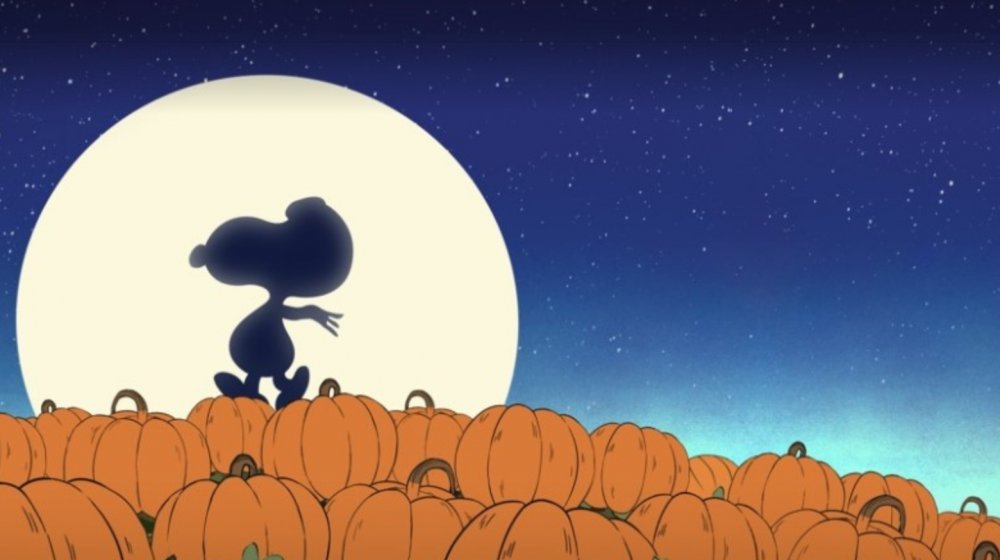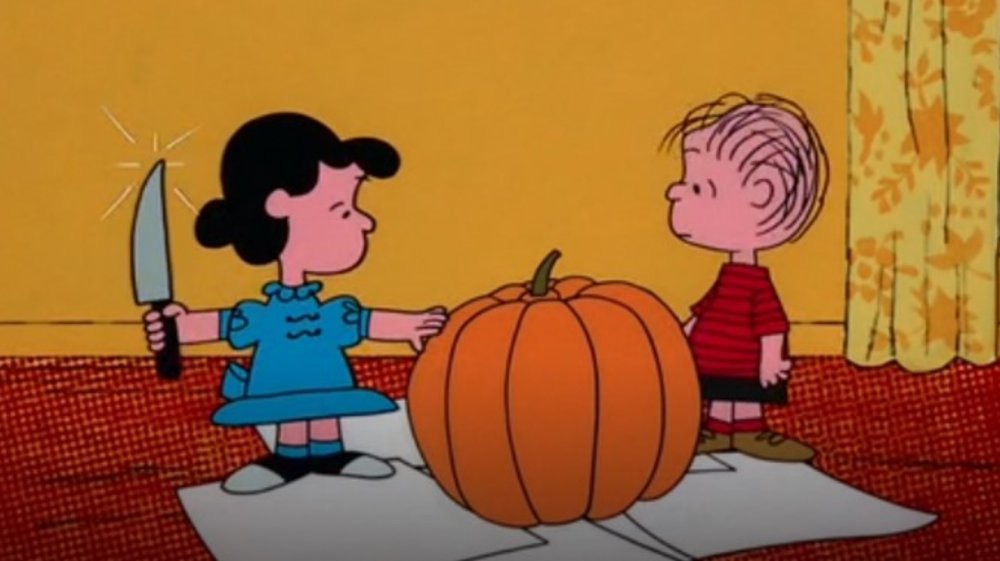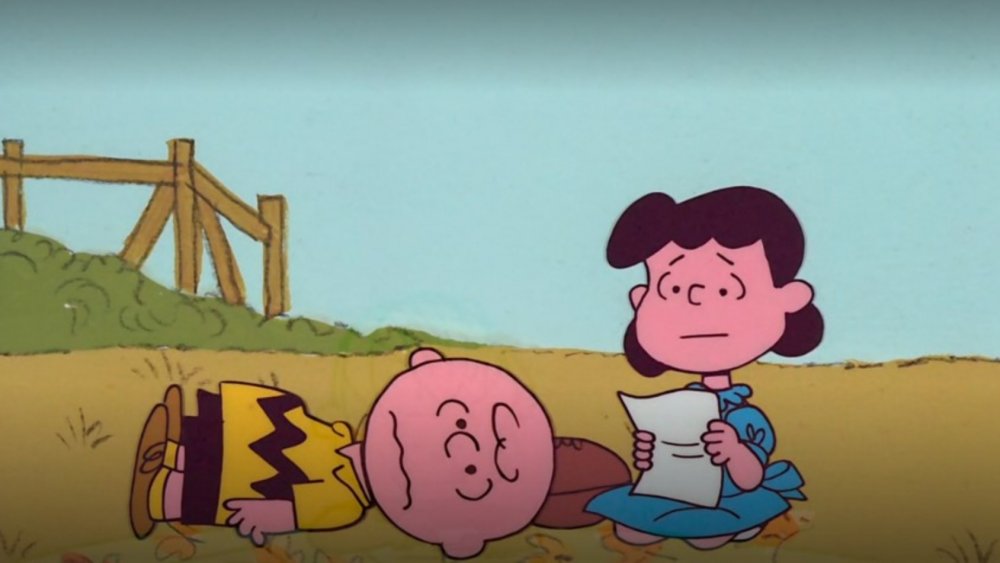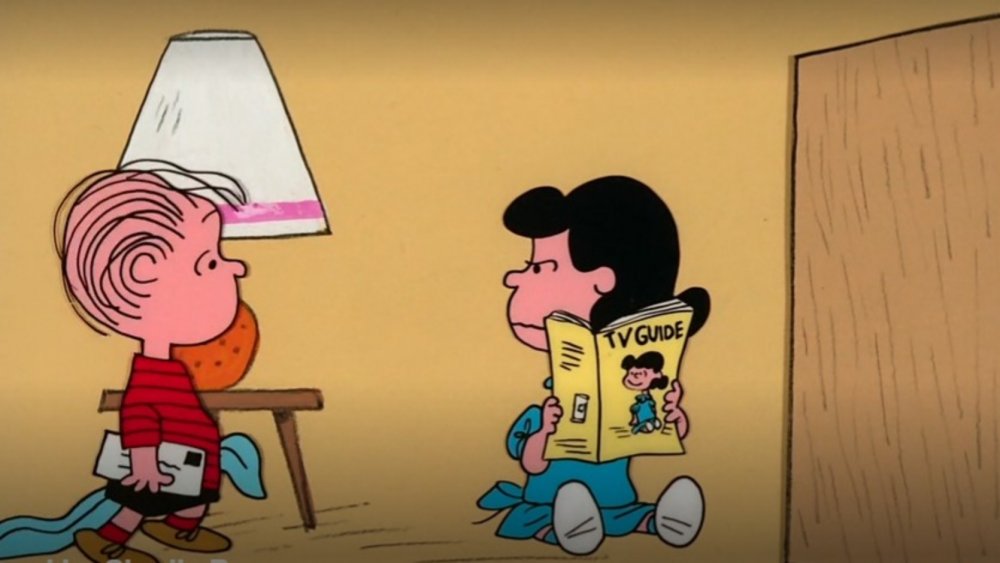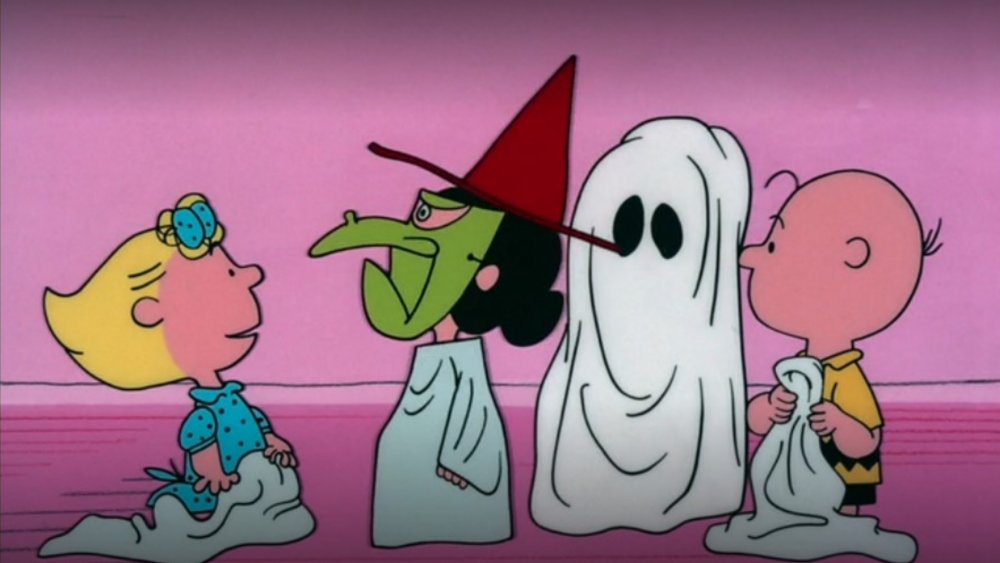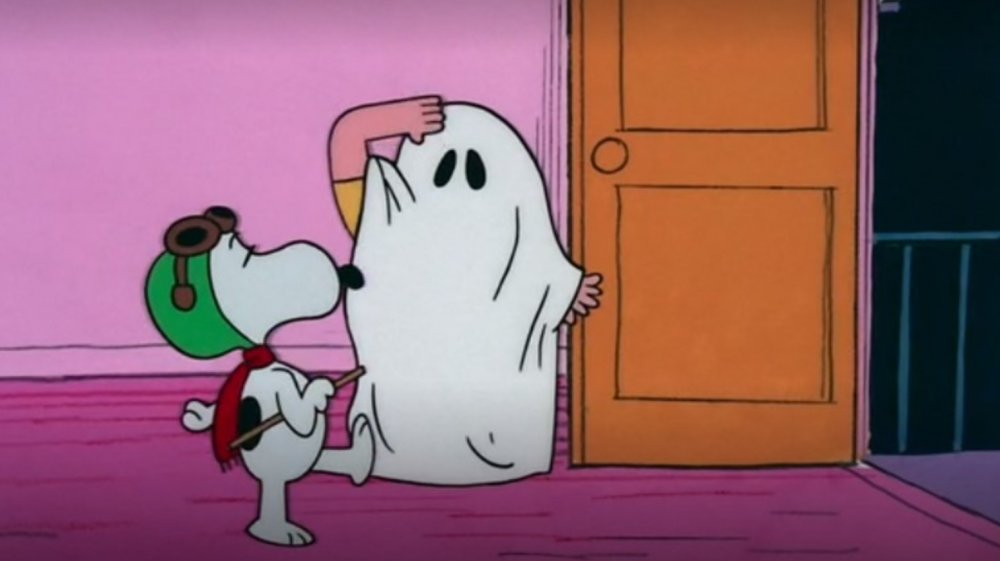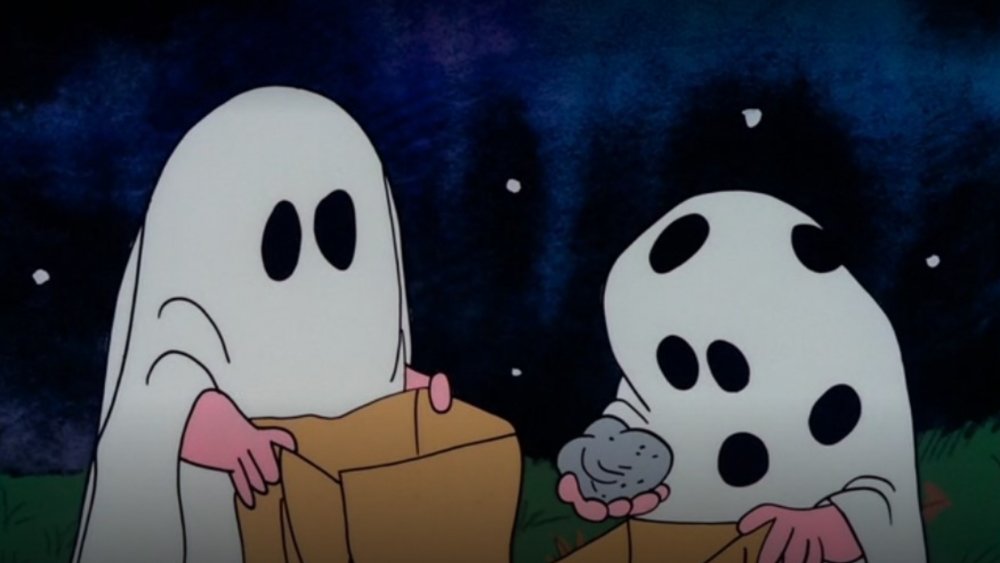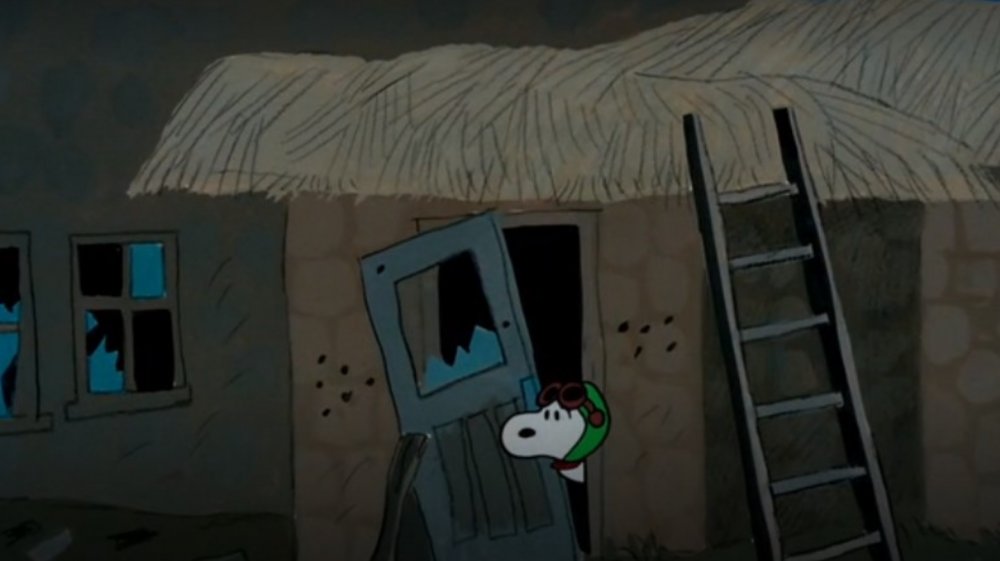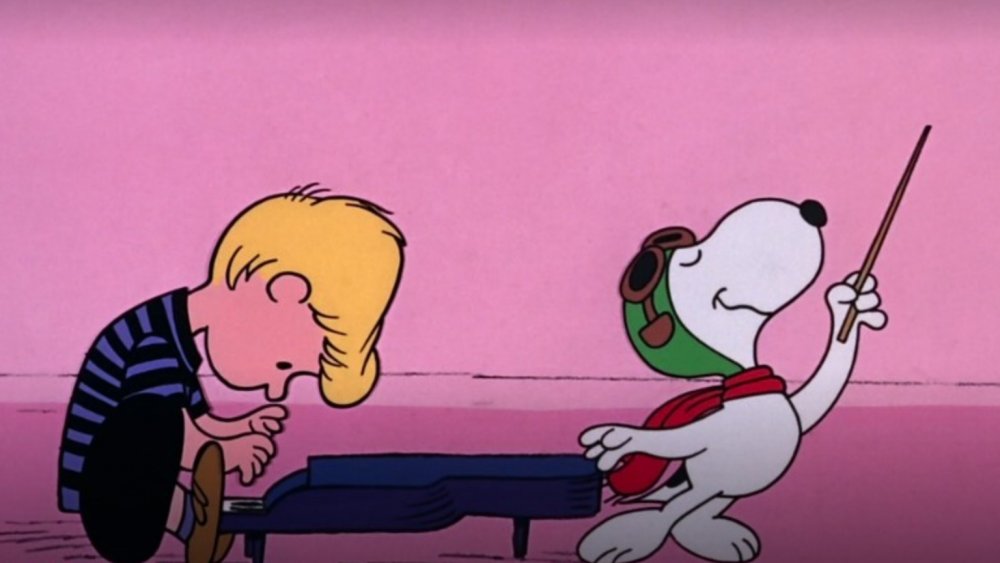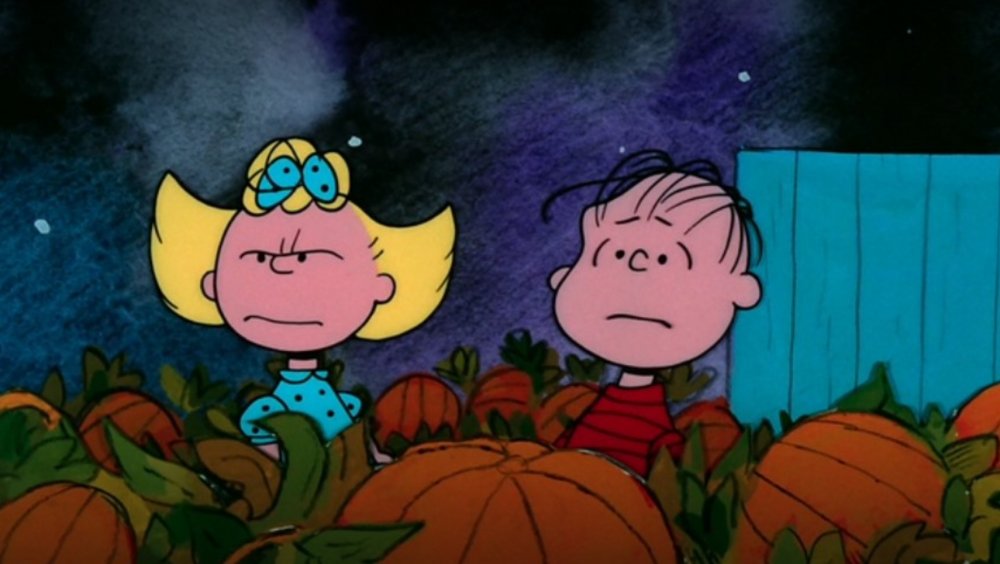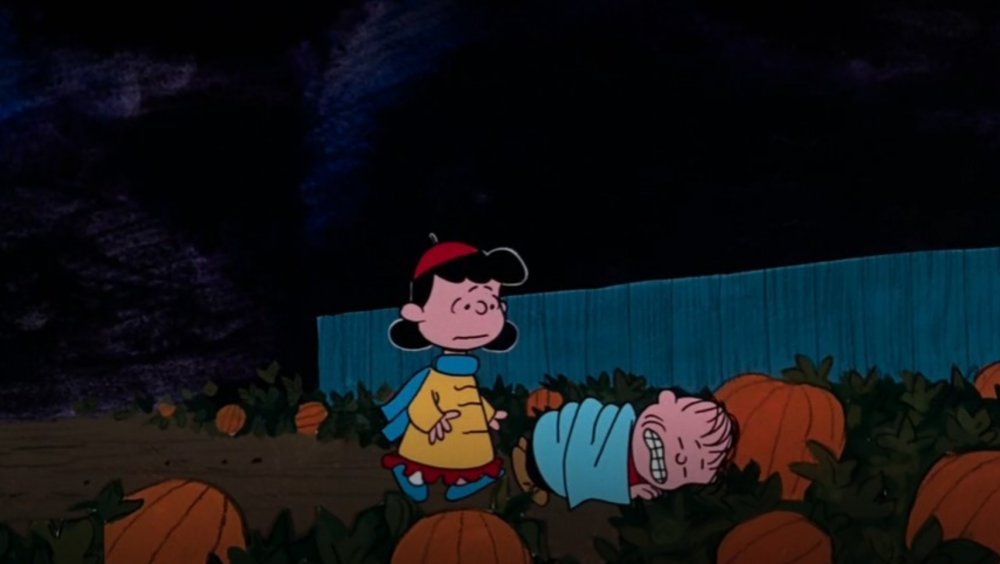Things Only Adults Notice In It's The Great Pumpkin, Charlie Brown
Every Halloween, an innocent boy treks out to a pumpkin patch with nothing but his trusty blanket and the sincere hope that the one and only Great Pumpkin will appear, bringing toys to all the good children of the world. Linus may have mixed up his favorite holiday with the tradition of Santa Claus, but for a generation of viewers, Halloween doesn't feel complete without the 1966 animated special It's the Great Pumpkin, Charlie Brown, based on the Peanuts comic strip by Charles M. Schulz.
While Charlie Brown and the rest of the Peanuts kids go trick-or-treating and attend a Halloween party, Linus waits patiently. Snoopy, the world's most imaginative beagle, eventually ruins Linus's plans — but not the boy's fervent belief. Just wait until next year, Linus insists with a childlike optimism that no one wants to spoil, no matter how old we get.
The mythical Great Pumpkin is one of those ideas that stays as sweet as your favorite chocolate bar, year after year. But other things in this Emmy-nominated program make less sense when you're an adult. Here are a few tricks we noticed in this evergreen Halloween treat.
Lucy's Friday the 13th-style cutlery
Adults don't appear in the Peanuts TV specials. (If they're heard at all, their voices sound like "Mwa-mwa-mwa-mwa," thanks to a trombone from one of the musicians in the Vince Guaraldi Trio, who often handled the Peanuts soundtracks.) While it's amusing to see the kids do so much for themselves, it's also occasionally disconcerting, such as when Lucy takes younger brother Linus to a nearby pumpkin patch to fetch a potential jack-o'-lantern. Linus creatively figures out that to transport this giant home, he has to roll it on its side, a tactic that would bruise a pumpkin in real life.
At home, Lucy sets about carving it, whipping out a knife that frightening costume favorite Jason Voorhees of Friday the 13th would envy. She expertly stabs the pumpkin's top, fashions a lid, and removes the pulp and seeds in front of a horrified Linus. "You didn't tell me you were gonna kill it!" he wails.
A bad pass
Linus isn't the only adorably naive friend in the Peanuts gang. The hapless Charlie Brown expects that things won't go his way — and they often don't — but he never fully loses hope, which spurs him to keep on trying. His famous struggle with Lucy over kicking a football that she promises to hold still, only to yank away at the last second, is a great example of this seesaw of doubts and perseverance. It was animated for the first time in It's the Great Pumpkin, Charlie Brown, where Lucy tantalizes Charlie with the football and some curious encouragement.
Instead of a verbal promise, Lucy presents him with a signed document where she swears not to pull the football away. Seeing the words in writing, Charlie runs, only to wind up flat on his back when Lucy goes against her word. "Peculiar thing about this document. It was never notarized," she says, a grown-up word and rationale that's appropriate from a girl who asks for real estate at Christmas.
It's the great meta gag, Charlie Brown
The Peanuts have a long history with television, appearing in more than 45 specials since the first one, 1965's A Charlie Brown Christmas. It's the Great Pumpkin, Charlie Brown was the third to air (after 1966's Charlie Brown's All Stars!), so there's no way that the creators could have known the longevity they'd have. But the Halloween adventure nevertheless references the beloved characters' relationship with television. At one point while watching TV, Lucy reads a copy of TV Guide with a dark-haired girl in a blue dress on the cover who looks suspiciously like her.
The meta moment comes after an annoyed Lucy tosses Snoopy offscreen (animal abuse!) and right before Linus leaves the house to mail his letter to the Great Pumpkin. TV Guide itself listed this among five fun facts about the animated special. "This last one is admittedly a little self-serving," the magazine noted, mystified but flattered nonetheless.
A rumble in Sally's brain
Part of the charm of the Peanuts specials is the juxtaposition between the young voice talent and the dialogue that makes them sound wiser than their years. Charlie Brown's younger sister Sally was voiced by Cathy Steinberg, who was just six years old at the time (and with a loose front tooth that changed her speech after it fell out).
Sally is thrilled to go trick-or-treating with her brother and the other kids for the first time, but she's also skeptical about this whole concept. Lucy explains all she has to do is ring the doorbell, say "Trick or treat," and get candy. "Are you sure it's legal?" Sally asks.
"Of course it's legal," Lucy replies.
"I wouldn't want to be accused of taking part in a rumble," Sally answers, using a slang term from the era that meant a street fight. It's also a synonym in Britain for illicit activity.
Is that a ghost, Charlie Brown?
As the Peanuts kids gather at Charlie Brown's house before going trick-or-treating, there's a mysterious child holding the door open. We know we're at Charlie Brown's house because Snoopy, the Brown family's beagle, is there, ready to depart on his own mission as a World War I Flying Ace, and Sally is getting dressed as a ghost. The others wander in and greet each other: Violet, Lucy (dressed as a ghost with a witch's mask), a boy dressed as a ghost with a coonskin cap (likely Schroeder, who often wore this hat), another ghost witch (either Freida or Patty, who taunted Linus earlier), and Pigpen, whose dirty sheet gives away his identity.
As they file out the door, a boy in a yellow short-sleeved shirt salutes Snoopy. But who is this kid? Charlie Brown is the only one in the episode who wears a short-sleeved yellow shirt, but he had "a little trouble with the scissors," turning his ghost costume into Swiss cheese. The credits mention Shermy among the voices, but that character usually wears brown. While this is no doubt an animation error — the kids that go door-to-door also seem to vary — it's quirky enough to imagine the spirit of Halloween, or at least a friendly guy named Casper, dropping by.
A rocky tradition
During Linus's pumpkin patch vigil, Charlie Brown goes trick-or-treating, only to receive a rock from every house in the neighborhood. It turns out that Charles Schulz's daughters came up with this running gag when they were kids. "Every once [in] a while, my sister and I thought it'd be fun to give somebody a rock," Jill Schulz, the cartoonist's youngest daughter, told The Wrap after the special's 50th anniversary. "I'm pretty sure they knew we were joking."
As absurd as is to hear Charlie say "I got a rock" each time he compares his haul against that of his friends, it also feels cruel. Without knowing the Schulz family's backstory, it looks like all the adults conspired to ensure the little guy got nothing but rocks all night. Young fans couldn't help but sympathize with poor Charlie, mailing candy to CBS after the show first aired and to the cartoonist's California studio for years afterward. Charles Schulz, who died in 2000 at age 77, never ate the candy but shared it with the office staff.
Imagination takes flight
A lot of the vignettes in It's the Great Pumpkin, Charlie Brown – Linus patient in the pumpkin patch, Lucy taunting Charlie Brown with the football – appeared in the Peanuts comic strip for years. Snoopy first assumed the disguise of a World War I Flying Ace in the comics in 1965, complete with "flying" atop his doghouse in his scarf and aviator hat to battle the Red Baron, the real-life nickname of a deadly German fighter pilot.
It's the Great Pumpkin, Charlie Brown marked the dogfighting pilot's animated debut, although young viewers might not have realized at first that Snoopy was dodging gunfire and crashing behind enemy lines in his imagination. The clever beagle is one vivid storyteller, passing a sign for the city of Châlons-sur-Marne in France, crawling through trenches topped with barbed wire, and skulking through shells of homes riddled with broken windows and bullet holes. Snoopy seems to be in a dodgy neighborhood until he ducks into an upstairs window, revealing that in reality, he's arrived at Violet's house where the kids are having their Halloween party.
A tuneful rollercoaster
Children as old as the Peanuts kids wouldn't recognize any of the songs that Schroeder plays on the piano after Snoopy arrives at the Halloween party. But anyone alive during World War I would, a tribute both to Schroeder's musical brilliance and Grammy-winning jazz musician Vince Guaraldi, who composed the music for the Peanuts specials. Schroeder's playing takes Snoopy on an emotional rollercoaster and, according to the official soundtrack, provides a sampling of wartime hits.
Schroeder first launches into "It's a Long Way to Tipperary," a British music hall number circa 1912 that became a popular marching song. Next is 1914's "There's a Long, Long Trail," during which Snoopy becomes sad about the song's sweethearts being apart. Schroeder puts a smile on the pup's face again with "Pack Up Your Troubles in Your Old Kit-Bag," another marching song from 1915. But 1916's "Roses of Picardy," another ballad about loved ones longing to see each other, brings Snoopy to tears. The dogged Flying Ace manages to pull himself together before heading back out on his mission.
The 20th century indeed
Sally's crush on Linus spurs her to ditch trick-or-treating and hang out in the pumpkin patch too, but she's not as steadfast in her belief as he is, leading to some humorous comments about gender dynamics. As the night wears on and her patience wears thin, Linus tries to reassure her that theirs is "the most sincere pumpkin patch" and that the Great Pumpkin "respects sincerity." That's a good story, she says.
"You don't believe the story of the Great Pumpkin? I thought little girls always believed everything that was told to them," Linus says. "I thought little girls were innocent and trusting."
"Welcome to the 20th century!" she says.
Snoopy certainly respects sincerity. Back to being the Flying Ace, he rustles undercover through the pumpkin patch, then rises, causing Linus to faint when he thinks the Great Pumpkin has actually appeared. Snoopy skedaddles just as Linus wakes, and Sally erupts over what a fool she's been. "I'll sue!" she says, taking grown-up dialogue from Lucy's notary. "You owe me restitution!"
"You've heard of the fury of a woman scorned, haven't you?" Linus explains when Charlie Brown wonders what's happened. "Well, that's nothing compared to the fury of a woman who has been cheated out of trick-or-treats."
A Peanut who's soft on the inside
It's the Great Pumpkin, Charlie Brown pokes fun at Lucy's brash attitude, having her don a witch's mask after saying how a person's costume should always contrast their personality. But the show reveals that she's more of a 3 Musketeers bar — soft on the inside — than the hardest of the Peanuts.
Lucy complains plenty about Linus embarrassing her with his Great Pumpkin pilgrimage, but she asks for extra candy for him at each house (admittedly while explaining how her "stupid brother" is on this quest). More significantly, she's the one who wakes up at 4AM to retrieve him from the pumpkin patch where he's shivering in his blanket, then tucks him into bed. (We know Charles Schulz's focus was the Peanuts point of view, but these absentee parents are downright weird by today's standards.)
It's the Great Pumpkin, Charlie Brown is full of subtext about life's disappointments, writes Jen Chaney in Vulture, but it's inspired "sincerity of the purest kind, the sort that really should be rewarded by a symbol of autumn who hands out presents to deserving little children." Real children shared their candy with Charlie Brown, feeling badly for the boy who got a bag of rocks. And when everyone else abandons Linus in the dark, his sister is the one to bring him home.
